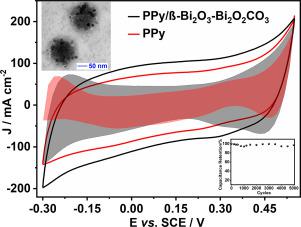β-Bi 2 O 3 -Bi 2 O 2 CO 3分散聚吡咯(PPy/β-Bi 2 O 3 -Bi 2 O 2 CO 3 )复合材料在吡咯乙腈溶液中电化学沉积在不锈钢网(SSM)表面上单体和预合成的β-Bi 2 O 3 -Bi 2 O 2 CO 3纳米粒子。该涂层与PPy均聚物涂层和β-Bi 2 O 3 -Bi 2 O 2 CO涂层进行了比较使用电化学阻抗谱 (EIS)、循环伏安法 (CV)、XPS、XRD、TEM 和 FESEM 对3 号粉末进行分析。含有β-Bi 2 O 3 -Bi 2 O 2 CO 3相的花状球形纳米粒子被封装在由小纳米球组成的部分氧化的PPy簇中,从而在复合材料中良好分散。由于 β-Bi 2 O 3 -Bi 2 O中 Bi 5+的电生成,PPy/β - Bi 2 O 3 -Bi 2 O 2 CO 3涂层表现出比 PPy 涂层更强的电容行为复合材料合成和超级电容器循环过程中的2 CO 3相。由于β-Bi 2 O 3 -Bi 2 O 2 CO 3和PPy的混合金属氧化物,涂层电极提供了更高的赝电容贡献(67.4%),在100 mM中表现出360 F g -1的比电容Li 2 SO 4。具有层状结构的Bi 2 O 2 CO 3有助于扩大活性表面积、导电性和催化性能。用聚乙烯醇(PVA)/Li 2制备固态不对称电池SO 4使用10 mg cm -2质量负载的PPy/β-Bi 2 O 3 -Bi 2 O 2 CO 3复合材料和聚氯乙烯(PVC)/碳涂覆的SSM电极。该器件在0.5 A g -1下提供64.2 Wh kg -1比能量和350 W kg -1比功率,库仑效率为90%,5000次循环的稳定性约为97%。该电极有潜力用作高性能超级电容器中的无粘合剂电极。
 "点击查看英文标题和摘要"
"点击查看英文标题和摘要"
Electrosynthesis of binder-free polypyrrole/nano- Bi2O3-Bi2O2CO3 composite for supercapacitor anode
β-Bi2O3-Bi2O2CO3 dispersed polypyrrole (PPy/β-Bi2O3-Bi2O2CO3) composite is electrochemically deposited on stainless steel mesh (SSM) surface in an acetonitrile solution of pyrrole monomer and pre-synthesized β-Bi2O3-Bi2O2CO3 nanoparticles. The coating is characterized compared with those of the PPy homopolymer coating and β-Bi2O3-Bi2O2CO3 powder using electrochemical impedance spectroscopy (EIS), cyclic voltammetry (CV), XPS, XRD, TEM, and FESEM. Flower-shaped spherical nanoparticles containing β-Bi2O3-Bi2O2CO3 phases are encapsulated in the partially oxidized PPy clusters composed of small nanospheres, thus dispersed well in the composite. The PPy/β-Bi2O3-Bi2O2CO3 coating exhibits a more capacitive behaviour than the PPy coating due to the electro-generation of Bi5+ in the β-Bi2O3-Bi2O2CO3 phases during the synthesis of composite and the supercapacitor cycling. The coated electrode provides a higher pseudocapacitive contribution (67.4 %) thanks to the mixed metal oxide of β-Bi2O3-Bi2O2CO3 in addition to PPy, exhibited a specific capacitance of 360 F g−1 in 100 mM Li2SO4. Bi2O2CO3 with a layered structure contributes to enlarge of active surface area, conductivity, and catalytic performance. A solid-state asymmetric cell is fabricated with polyvinyl alcohol (PVA)/Li2SO4 using 10 mg cm−2 mass-loaded PPy/β-Bi2O3-Bi2O2CO3 composite- and polyvinyl chloride (PVC)/carbon- coated SSM electrodes. The device provides 64.2 Wh kg−1 specific energy and 350 W kg−1 specific power at 0.5 A g−1 with a coulombic efficiency of 90 % and high stability of about 97 % for 5000 cycles. The electrode has the potential to be used as a binder-free electrode in high-performance supercapacitors.



































 京公网安备 11010802027423号
京公网安备 11010802027423号